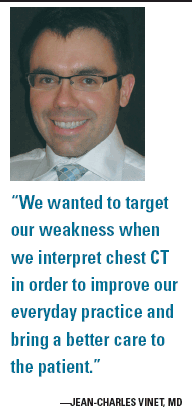PET/CT picks up additional lesions not found on chest CT
Thoracic CT scans in cancer patients require careful inspection in order to pinpoint previously undetected lesions, according to a study by Canadian radiologists. Jean-Charles Vinet, MD, and colleagues found that PET/CT detected an additional 20% of lesions from the supraclavicular notch to the adrenals that were not found on chest CT alone.
Thoracic CT scans in cancer patients require careful inspection in order to pinpoint previously undetected lesions, according to a study by Canadian radiologists. Jean-Charles Vinet, MD, and colleagues found that PET/CT detected an additional 20% of lesions from the supraclavicular notch to the adrenals that were not found on chest CT alone.
“A more careful scrutiny may be required to assess thoracic CT in an oncologic population, especially regarding supraclavicular nodes, since most of the discrepancies were found in this region,” said Dr. Vinet, who is a radiology resident at the Centre Hospitalier de l’Universite de Montreal.

For their retrospective study, Dr. Vinet’s group included 499 patients from a pool of 3,000 people who had PET/CT for an oncologic purpose at their institution between March and December 2007 (RSNA 2008 abstract SSA18-06).
PET/CT and CT reports were reviewed to identify all PET/CT active lesions from the supraclavicular notch to the adrenals that were not mentioned in the thoracic CT report. For each discordant report, a radiology resident, a senior chest radiologist, and a nuclear medicine specialist reviewed the images to characterize, localize, and determine if the lesion was visible, but not reported, or had radiologic benignity criteria.
If the lesion was not reported, or was reported as benign on the chest CT, it was considered to be a discordant lesion, Dr. Vinet said.
Of the 499 patients included in the study, the discrepancy rate was 21.4% with a total of 138 lesions in 107 patients. Discordant lesions were mostly seen in the lymph nodes and bone structures, according to Dr. Vinet.
Suspicious lesions in the lymph nodes were larger than 10 mm with a mean diameter of 10.9 mm. Other overlooked lesions were located within bones, adrenals, liver, lung parenchyma, and soft tissues.
PET/CT demonstrated additional lesions not reported on chest CT in one-fifth of patients, the researchers found.
“These additional findings can be explained by the increased intrinsic sensitivity of the PET/CT compared to CT alone,” he said. In addition, some lesions were overlooked on the initial chest CT readings, most of which were proven to be malignant. PET/CT had a positive clinical impact in about one-third of patients, Dr. Vinet said.
Targeting CT weakness
A more careful scrutiny may be required to assess thoracic CT in an oncologic population, especially regarding supraclavicular nodes, since most of the discrepancies were found in this region,” he said.
Even though PET/CT has been proven to be more sensitive than chest CT alone in detecting some types of cancer, chest CT is still among the first exams prescribed to patients with a known or suspected malignancy, Dr. Vinet said.
“In our everyday practice, we found that some lesions were not reported on the chest CT but were retrospectively visible when we did the PET/CT and knew where they were localized,” he said.
Previous studies that compared PET/CT to CT alone did not consider patients with various malignancies in a specific region but rather the performance for a specific type of cancer, according to Dr. Vinet.
“We wanted to target our weakness when we interpret chest CT in order to improve our everyday practice and bring a better care to the patient,” he said.
Commentary
Donald Podoloff, MD, remarked that if lesions remain undetected, the patient could be mis-staged and possibly undertreated.
“It has been known for a long time that nodes that are not enlarged by radiographic criteria can contain tumors and be PET positive,” said Dr. Podoloff, who is the division head of nuclear medicine at M.D. Anderson Cancer Center in Houston.
He also pointed out that interpretation results are likely to vary when scans are read by specialists at a major cancer center.